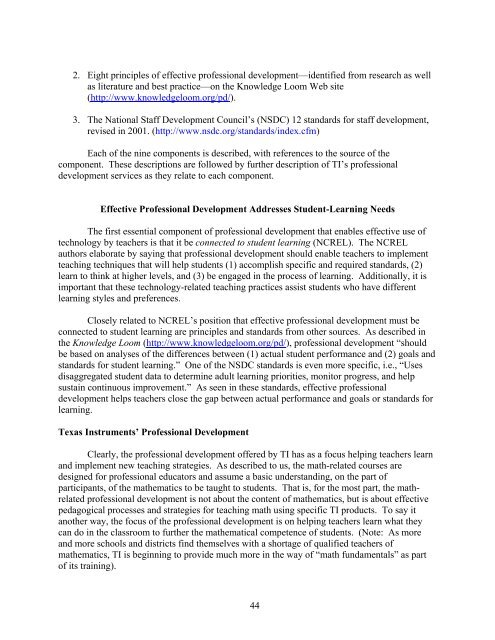Professional Development - Vol. IV, Part I
Professional Development - Vol. IV, Part I
Professional Development - Vol. IV, Part I
You also want an ePaper? Increase the reach of your titles
YUMPU automatically turns print PDFs into web optimized ePapers that Google loves.
2. Eight principles of effective professional development—identified from research as well<br />
as literature and best practice—on the Knowledge Loom Web site<br />
(http://www.knowledgeloom.org/pd/).<br />
3. The National Staff <strong>Development</strong> Council’s (NSDC) 12 standards for staff development,<br />
revised in 2001. (http://www.nsdc.org/standards/index.cfm)<br />
Each of the nine components is described, with references to the source of the<br />
component. These descriptions are followed by further description of TI’s professional<br />
development services as they relate to each component.<br />
Effective <strong>Professional</strong> <strong>Development</strong> Addresses Student-Learning Needs<br />
The first essential component of professional development that enables effective use of<br />
technology by teachers is that it be connected to student learning (NCREL). The NCREL<br />
authors elaborate by saying that professional development should enable teachers to implement<br />
teaching techniques that will help students (1) accomplish specific and required standards, (2)<br />
learn to think at higher levels, and (3) be engaged in the process of learning. Additionally, it is<br />
important that these technology-related teaching practices assist students who have different<br />
learning styles and preferences.<br />
Closely related to NCREL’s position that effective professional development must be<br />
connected to student learning are principles and standards from other sources. As described in<br />
the Knowledge Loom (http://www.knowledgeloom.org/pd/), professional development “should<br />
be based on analyses of the differences between (1) actual student performance and (2) goals and<br />
standards for student learning.” One of the NSDC standards is even more specific, i.e., “Uses<br />
disaggregated student data to determine adult learning priorities, monitor progress, and help<br />
sustain continuous improvement.” As seen in these standards, effective professional<br />
development helps teachers close the gap between actual performance and goals or standards for<br />
learning.<br />
Texas Instruments’ <strong>Professional</strong> <strong>Development</strong><br />
Clearly, the professional development offered by TI has as a focus helping teachers learn<br />
and implement new teaching strategies. As described to us, the math-related courses are<br />
designed for professional educators and assume a basic understanding, on the part of<br />
participants, of the mathematics to be taught to students. That is, for the most part, the mathrelated<br />
professional development is not about the content of mathematics, but is about effective<br />
pedagogical processes and strategies for teaching math using specific TI products. To say it<br />
another way, the focus of the professional development is on helping teachers learn what they<br />
can do in the classroom to further the mathematical competence of students. (Note: As more<br />
and more schools and districts find themselves with a shortage of qualified teachers of<br />
mathematics, TI is beginning to provide much more in the way of “math fundamentals” as part<br />
of its training).<br />
44

















